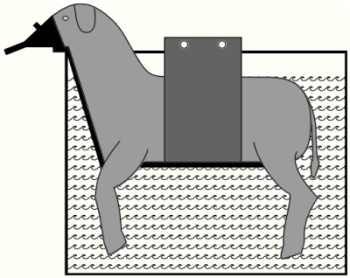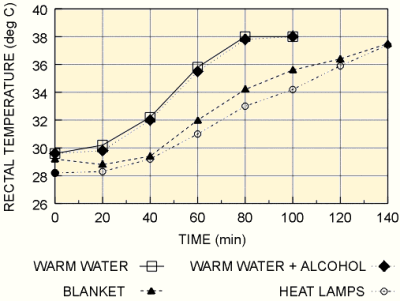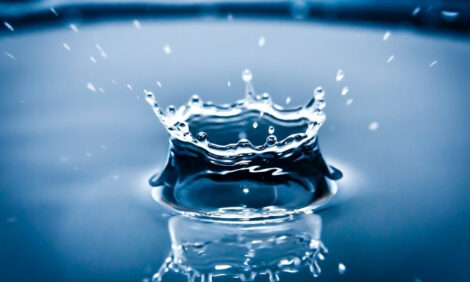



Rewarming Chilled Calves
By Barry Robinson, Ph.D., Great Northern Livestock Consulting Ltd. Alberta Dairy Management. Calving during the winter with its associated difficulties is a challenge that is faced by all Alberta dairy producers.
Under most circumstances, cows and heifers are brought into a shelter prior to calving because of ease of management and for fear of losing newborn calves to the cold. However, occasionally calves are born outdoors during cold weather.
If you are fortunate, the cow or heifer is a good mother and takes care of the calf, if not or if it is 40 below, the calf may experience a bout of hypothermia - a reduction in the core temperature of the animal. When you find a hypothermic calf, what should you do?
At the University of Alberta, Dr. Bob Christopherson, Dr. BruceYoung and I conducted practical research into rewarming hypothermic calves. Based on this research, I will give recommendations how to maximize survival of hypothermic calves.
Four methods of rewarming
To conduct rewarming research, the body temperature of newborn calves, prior to suckling and during their first 24 hours of life, was artificially reduced through a water immersion technique (see figure 1). Normal rectal temperature for cattle is 38.5 °C. Once the calf's rectal temperature reached 30 °C it was randomly allocated to one of 4 practical rewarming treatments, as follows :
- warm water immersion;
- warm water immersion plus alcohol;
- a blanket for insulation, or;
- warming with heat lamps.

Figure 1 : Illustration of the water immersion apparatus for cooling and subsequent rewarming of hypothermic calves. The mask permitted the measurement of inhaled and exhaled gases so that metabolic heat production could be calculated.
In both warm water techniques, the cool water in the water bath was gradually replaced with 38 °C water and the calves remained in the warm water until rectal temperature returned to normal.
In the warm water plus alcohol treatment, the calves were rewarmed in the same way as described above. Additionally, they were drenched with 40 ml of a 1:1 mixture of commercial brandy and water to determine whether the alcohol would assist in the rewarming.
In the blanket treatment, the calves were removed from the cool water, dried off by vigorous rubbing with a dry towel, wrapped in a blanket and placed in a 20 °C room until rewarming was completed.
In the heat lamp treatment, calves were removed from the cool water and were dried off by vigorous rubbing and placed under two 250 watt heat lamps in a 20 °C room.
During cooling and recovery, rate of metabolic heat production and rectal temperature were continuously monitored.
The rate of warming was greatly influenced by the selected treatment. As shown in figure 2, the warm water immersion procedures are the most rapid, however they also require the most effort, particularly in persuading your spouse to allow you to put the calf into your bathtub. The kids will love it!

Figure 2. Rectal temperature of newborn calves during recovery from hypothermia in four different rewarming treatments.
Recommendations
Based on our research, the outlook for hypothermic calves is very good. If a hypothermic calf is located there is an excellent chance for full recovery as long as none of the limbs are frozen. In our experiments, all calves successfully recovered and were energetically looking for milk shortly after recovery.Warm water immersion is the procedure of choice if you are in a hurry for the calf to recover or if the calf has a compromised ability to produce heat. A compromised ability to produce metabolic heat will occur if the calf is premature or if it is deeply hypothermic. One reason a premature animal can not produce adequate internal heat is that their lungs are not fully developed. Therefore, the calf can not take up ample oxygen to run the internal metabolic engine at full speed.
Many farmers give alcohol to hypothermic calves in an effort to speed recovery. In our experiment the alcohol did not increase the rate of recovery of hypothermic calves in the warm water treatment.
The blankets and the heat lamp techniques were also successful in rewarming the calves. Although these techniques were significantly slower, they also required less labour. The heat lamps must be protected or the lamps may be broken by a struggling calf.
Calving in the winter is a challenge, particularly if you must deal with the occasional hypothermic calf. However, if a hypothermic calf is found, take the time to rewarm it because the chances for complete recovery are very good.
Based on our research, if you find a deeply hypothermic calf with a rectal temperature less than 30 °C or if the calf is premature, the warm water rewarming technique is recommended. Simply use warm bath water. If the calf is mildly hypothermic with a rectal temperature greater than 30 °C, dry the calf by vigorous rubbing, wrap it in a dry blanket and put the calf in a warm dry area. In addition to saving a calf for your dairy, there is great satisfaction in saving a young life.
January 2008


